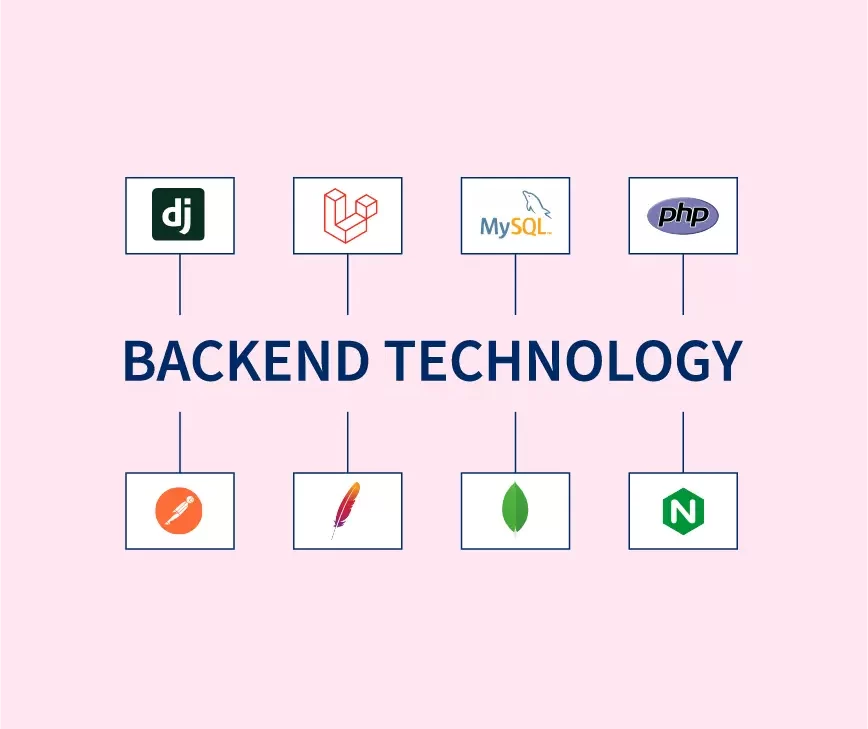The back end of an application is just as important as its front end. It is the backbone of an application that ensures smooth functioning and optimal performance. Backend development includes three major components: server, database, and logic. In this blog post, we will be discussing the top 10 backend technologies that every developer should know about. These technologies are chosen based on their popularity, functionality, and versatility.
Contents
1. Node.js
Node.js is an open-source cross-platform JavaScript runtime environment built on Chrome’s V8 engine. It evolved as a way to create web servers with a non-blocking I/O model that can handle a large number of connections simultaneously. Node.js can be used for both server-side and client-side scripting, making it a popular choice among developers. The advantages of using Node.js include high scalability, speed, and productivity. However, its main disadvantage is its asynchronous programming style, which can make code harder to read and maintain. Node.js has been used in various projects, including PayPal, Netflix, and LinkedIn.
2. Ruby on Rails
Ruby on Rails, commonly referred to as RoR, is a web development framework written in Ruby language. It is designed to make web application development more accessible, faster, and more efficient. RoR heavily relies on convention over configuration principles, which means that it has a standardized structure for its components. RoR has key features such as security, scalability, and flexibility. It also has a vast community where developers can easily find help and support. Compared to other backend technologies, RoR might take some time to learn due to its specific syntax. RoR has been used in projects such as Basecamp, Airbnb, and GitHub.
3. Django
Django is a high-level Python web framework designed to help developers build web applications quickly and efficiently. Django is a free and open-source framework that follows the Model-View-Controller (MVC) pattern. Django features include its fast development environment, built-in security features, and scalability. Its limitations include tight coupling, slow performance in specific use cases, and the need to conform to certain conventions. Django has been used in various projects, including Instagram, Mozilla, and Spotify.
4. ASP.NET
ASP.NET is a free web framework for building dynamic web applications created by Microsoft. It is a server-side technology that allows developers to build dynamic web pages, which use server-side technology to interact with databases and create customized content. ASP.NET has several benefits such as cross-platform, real-time web functionality, and multi-language support. However, its limitations include the need for additional software to run on non-Windows machines. ASP.NET has been used in various projects such as The Washington Post, Dell, and GoDaddy.

5. Laravel
Laravel is a free, open-source PHP web application framework designed for building web applications following the model-view-controller (MVC) architectural pattern. It emphasizes code readability and is known for its elegant syntax. Laravel’s features include high speed, scalability, and an active community. However, its main challenge is the steep learning curve for beginners. Laravel has been used in projects including Deltanet Travel and Bytelogic Technologies.
6. Flask
Flask is a micro web framework written in Python that is intended to make it easier to build small web applications quickly. Flask is known for its lightweight design and simplicity. Flask’s features include flexibility, simple syntax, and extensibility. However, Flask’s micro nature might make it unfit for building large-scale applications. Flask has been used in various projects such as Pinterest, LinkedIn, and Twilio.
7. Spring
Spring is an open-source application framework created for building enterprise-level Java applications. It has evolved over the years to include various tools and extensions for enterprise-level applications. Spring’s benefits include extensibility, security, and object-relational mapping. However, Spring’s drawbacks include a steep learning curve and heavy configuration. Spring has been used in various projects such as TicketMaster, Zillow, and Samsung.
8. Express.js
Express.js is a web application framework for Node.js designed for building web applications and APIs. Express.js is known for its minimalist design and flexibility. Express.js features include easy routing, template engines, and middleware support. However, Express.js has some limitations such as poor memory use and poor performance in some cases. Express.js has been used in various projects such as IBM, Uber, and Accenture.
9. Kotlin
Kotlin is a free and open-source programming language with full Java interoperability. It has been supported by Google as an officially supported language for developing Android apps. Kotlin’s features include null safety, extension functions, and operator overloading. Kotlin’s benefits include ease of learning, reduced boilerplate code, and high integration with Java language code. Kotlin has been used in projects like Pinterest, Evernote, and Gradle.
10. MongoDB
MongoDB is an open-source, cross-platform document-oriented database management system. It uses a NoSQL document model and is designed to provide high scalability, speed, flexibility, and performance. MongoDB’s benefits include high scalability, high performance, and ease of use. However, MongoDB can be expensive, and it lacks some features present in traditional SQL databases. MongoDB has been used in various projects such as Forbes, The Guardian, and Zendesk.
Best Backend Technologies, Conclusion:
Backend technologies are vital for developers in creating efficient and high-performing applications. The top 10 backend technologies discussed in this blog post, including Node.js, Ruby on Rails, Django, ASP.NET, Laravel, Flask, Spring, Express.js, Kotlin, and MongoDB, provide developers with variety, scalability, versatility, and speed. Choosing the right backend technology depends on the project’s needs, developers’ skills, and budget. It is good to note that each backend technology has its advantages and disadvantages, and developers should choose what works best for their specific project.

